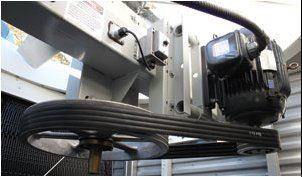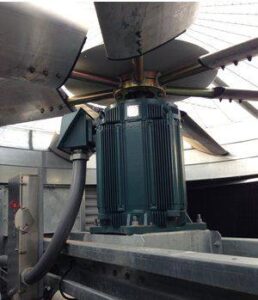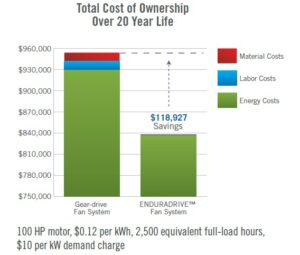When specifying and designing systems with cooling towers, the fans can play a very big part. These fans have the ability to alter the tower’s efficiency, noise levels, and capacity. Every cooling tower is equipped with a fan that requires a mechanism to transfer energy from the motor to the fan shaft. This can be achieved either directly or indirectly, depending on the chosen method.
Indirect drivers utilize gears or belts to transfer energy. Gears are used to transmit energy, while belts connect the motor shaft to a grooved wheel called a “sheave” which holds the belt, as shown in the image below.

On the other hand, direct drivers are a more modern and efficient approach. They employ permanent magnet motors that directly power the fan, eliminating the need for transmission components. Baltimore Aircoil Company refers to this as the EnduraDrive fan system, as displayed below.

Compared to indirect methods, direct magnetized motors typically consume up to 10% less energy. Direct drives are also more maintenance-friendly, requiring only a fraction of the lubricant needed by indirect drivers. They can go up to seven years between lubrication, significantly reducing maintenance costs.
However, this does not mean that indirect methods are ineffective; they can be effective with proper maintenance. Choosing between direct and indirect drivers involves considering the trade-off between initial cost and lifecycle cost.
Gear drives are common for larger horsepower applications and have a low initial cost but they require the highest maintenance and pose a risk due to the potential of highest downtimes. When dealing with gear driven fans, it is always recommended to periodically check alignment and to conduct timely oil changes.
Belt drives are a good in-the-middle option when looking at initial costs and lifecycle costs. It is recommended to check the belt tension quarterly and replace the belt periodically (every 3 years if connected to a VFD). These belt drive options provide an ease of service and lower maintenance costs than gear driven systems. The best application for these belt driven systems is when redundancy is preferred so that pony motors can be utilized in order to avoid downtime.
The EnduraDrive system requires the least maintenance (up to 90% reduction in maintenance costs) as there are no transmission components. There is no alignment required and required very little relubrication (as much as 7 years between service!). If your project is willing to spend more at the initial phase, they can save a lot of money as these systems have the lowest total cost of ownership when considering lifecycle costs. When considering the lifecycle costs of a cooling tower fan system, the savings for an owner with a direct driven fan system compared to a gear driven system can vary depending on various factors. However, comparisons are available, as shown in the image below:

In conclusion, the choice of cooling tower fan drivers plays a crucial role in system efficiency and maintenance costs. Indirect methods, employing gears or belts, have their advantages but require more maintenance and pose potential risks. Direct drivers, like the EnduraDrive system, offer superior energy efficiency and significantly reduced maintenance needs, resulting in substantial cost savings over the system’s lifecycle. Engineers must carefully consider the trade-off between initial cost and long-term benefits when selecting the most suitable driver, ensuring optimal performance and cost-effectiveness for cooling tower systems.
By: Nash Mohammad, B.Eng
